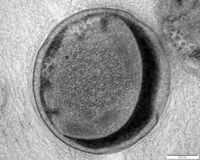Colony collapse disorder
Background
Colony collapse disorder (CCD) is a poorly understood phenomenon where large-scale, unexplained losses of adult worker honey bee colonies result in the bee colony. As of today, it is believed that many factors together is contributing to the underlying cause of the phenomenon. [6][10]. The phenomenon is often coupled with abnormal decrease in bee population and could be identified throughout the history of bee keeping. The phenomenon has been associated to various names including autumn collapse, spring dwindle, disappearing disease, May disease, and fall dwindle disease. However, the phenomenon was renamed as colony collapse disorder in late 2006 after considering previous names was not reflecting the nature of the condition. [6]. Recent studies have tried to link microbial contributions to this phenomenon. Virus such as Israeli acute paralysis virus and Kashmir bee virus have been suspected to play an important role in this phenomenon. [6].

